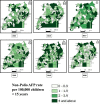Trends of key surveillance performance indicators of acute flaccid paralysis: a descriptive analysis, Uganda, 2015-2020
- PMID: 36071410
- PMCID: PMC9449289
- DOI: 10.1186/s12889-022-14077-w
Trends of key surveillance performance indicators of acute flaccid paralysis: a descriptive analysis, Uganda, 2015-2020
Abstract
Background: Polio is disease caused by poliovirus which can in turn cause irreversible paralytic disease, presenting as Acute Flaccid Paralysis (AFP). A sensitive AFP surveillance system, in which all reported AFP cases are evaluated, first to determine if they are true AFP cases or not, is key for tracking polio eradication. True AFP cases are then later categorized as polio AFP or non-polio AFP (NPAFP) cases. Sensitivity is defined by meeting an annual NPAFP rate/100,000 population < 15 years of ≥ 4/100,000, and an annual stool adequacy (SA) rate of ≥ 80%. We describe Uganda's AFP surveillance performance between 2015-2020, based on the WHO-recommended indicators, including; NPAFP and stool adequacy rate.
Methods: We performed a descriptive analysis of national AFP surveillance data, 2015-2020 obtained from ministry of health. We evaluated proportion of reported AFP cases that were true AFP, and changes in NPAFP and stool adequacy (SA) rate over the study period. We evaluated the trends in achieving the targeted NPAFP and SA rates from 2015-2020. We used QGIS to illustrate patterns in NPAFP and SA rates across districts and subregions.
Results: Among 3,605 AFP cases reported and investigated countrywide from 2015-2020, 3,475 (96%) were true AFP cases. All the true AFP cases were non-polio related. District reporting was near-complete (97-100% each year). Overall, the mean NPAFP rate declined from 3.1/100,000 in 2015 to 2.1/100,000 in 2020. Less than 40% of districts met the NPAFP target rate in all years. The proportion of districts achieving the NPAFP target rate of ≥ 4/100,000 significantly declined from 35% in 2015 to 20% in 2020. The mean annual SA rate nationally was 88% from 2015-2020. Only 66% of districts achieved the SA target rate of ≥ 80% in the study period. The proportion of districts with SA rate ≥ 80% significantly increased from 68 to 80% between 2015 and 2020.
Conclusion: Most districts reported AFP cases. However, there was a decline in the NPAFP rate from 2015-2020 and few districts achieved the target rate. The suboptimal AFP surveillance system performance leaves the country at risk of missing ongoing poliovirus transmission. We recommend health worker training on active AFP searches, intensified supportive supervision, increase the number of environmental surveillance sentinel sites to boost AFP surveillance in the country, and periodic review meetings with districts to assess AFP surveillance performance.
Keywords: AFP; Eradication; Polio; Surveillance; Uganda.
© 2022. The Author(s).
Conflict of interest statement
The authors declare that they have no competing interests.
Figures





Similar articles
-
The sensitivity of acute flaccid paralysis surveillance - the case of South Sudan: retrospective secondary analysis of AFP surveillance data 2014-2019.Pan Afr Med J. 2022 Jun 11;42(Suppl 1):12. doi: 10.11604/pamj.supp.2022.42.1.33965. eCollection 2022. Pan Afr Med J. 2022. PMID: 36158926 Free PMC article.
-
Strengthening acute flaccid paralysis surveillance post Ebola virus disease outbreak 2015 - 2017: the Liberia experience.Pan Afr Med J. 2019 May 27;33(Suppl 2):2. doi: 10.11604/pamj.supp.2019.33.2.16848. eCollection 2019. Pan Afr Med J. 2019. PMID: 31402963 Free PMC article.
-
Acute flaccid paralysis surveillance performance from 2011 to 2020 in Jonglei State, South Sudan: progress and challenges encountered.Pan Afr Med J. 2022 Jun 11;42(Suppl 1):11. doi: 10.11604/pamj.supp.2022.42.1.33966. eCollection 2022. Pan Afr Med J. 2022. PMID: 36158927 Free PMC article.
-
The critical role of acute flaccid paralysis surveillance in the Global Polio Eradication Initiative.Int Health. 2017 May 1;9(3):156-163. doi: 10.1093/inthealth/ihx016. Int Health. 2017. PMID: 28582560 Review.
-
[Acute Flaccid Paralysis].Brain Nerve. 2022 Oct;74(10):1153-1162. doi: 10.11477/mf.1416202203. Brain Nerve. 2022. PMID: 36198640 Review. Japanese.
Cited by
-
A circulating vaccine-derived poliovirus type 2 outbreak in a chronic conflict setting: a descriptive epidemiological study in South Sudan - 2020 to 2021.BMC Infect Dis. 2023 Nov 21;23(1):816. doi: 10.1186/s12879-023-08758-z. BMC Infect Dis. 2023. PMID: 37990165 Free PMC article.
-
The sensitivity of acute flaccid paralysis surveillance - the case of South Sudan: retrospective secondary analysis of AFP surveillance data 2014-2019.Pan Afr Med J. 2022 Jun 11;42(Suppl 1):12. doi: 10.11604/pamj.supp.2022.42.1.33965. eCollection 2022. Pan Afr Med J. 2022. PMID: 36158926 Free PMC article.
-
Community-Based Surveillance of Acute Flaccid Paralysis: A Review on Detection and Reporting Strategy.J Epidemiol Glob Health. 2025 Feb 20;15(1):29. doi: 10.1007/s44197-025-00349-2. J Epidemiol Glob Health. 2025. PMID: 39976723 Free PMC article. Review.
-
Tracking acute flaccid paralysis in Niger: a half-decade epidemiological portrait (2016-2021).BMC Infect Dis. 2025 Jan 17;25(1):79. doi: 10.1186/s12879-025-10457-w. BMC Infect Dis. 2025. PMID: 39825249 Free PMC article.
References
-
- World Health Organization . Surveillance standards for vaccine-preventable diseases. 2. Geneva: World Health Organization; 2018.
-
- Fact sheets: Poliomyelitis [https://www.who.int/news-room/fact-sheets/detail/poliomyelitis]
-
- Poliomyelitis (polio) [https://www.who.int/health-topics/poliomyelitis#tab=tab_1]
Publication types
MeSH terms
Supplementary concepts
Grants and funding
LinkOut - more resources
Full Text Sources
Medical
Miscellaneous

